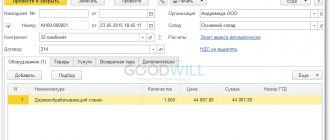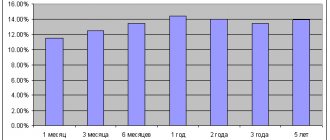Rules for calculating tax depending on the type of its base
A legal entity is subject to property tax on objects that constitute its fixed assets, i.e. movable (except for preferential) and immovable property (clause 1 of Article 374 of the Tax Code of the Russian Federation). In the general case, tax is calculated based on such a calculated value as the average (for the year - average annual) value of all property (clause 1 of Article 375 of the Tax Code of the Russian Federation).
However, part of the property owned by a legal entity (some real estate) has its own special tax base (cadastral value), determined by cadastral valuation (clause 2 of Article 375 of the Tax Code of the Russian Federation). Tax on such objects must be calculated separately.
The calculation of property tax for the year for them is quite simple: the cadastral value established for a specific object at the beginning of the year, after applying benefits to it (if any), is multiplied by the tax rate (clause 13 of Article 378.2 of the Tax Code of the Russian Federation). The cost involved in this calculation is, if necessary, adjusted by coefficients that take into account the shares of ownership and location of the object in different constituent entities of the Russian Federation. If at the beginning of the year the cadastral value has not been established, then the object will be included in the volume of property, the tax for which is calculated from the average (average annual) value (subclause 2, clause 12, article 378.2 of the Tax Code of the Russian Federation).
The formula for calculating the tax on the average (average annual) cost is similar to the above, i.e. this calculation itself is also simple. But in order to implement it, you must first calculate the size of the base, defined as the average (average annual) cost. And this calculation is not simple. Therefore, we will consider in more detail how to calculate the average annual value of property for the year, which forms the tax base that is usually applied to most of the property owned by a legal entity.
To calculate the average annual value of property subject to tax, it is necessary to determine 2 indicators for 13 dates (12 of which are the first days of each month, and the 13th is the last day of the accounting year) based on accounting records.
Each of the indicators represents the total residual value of the property (clause 3 of Article 375 of the Tax Code of the Russian Federation), separately calculated for the objects:
- recognized as taxable;
- preferential
To obtain the first of the values, from the total residual value of all property recorded as fixed assets (including that for which depreciation and not depreciation is charged), you need to exclude the cost:
- objects taxed from another (cadastral) base;
- objects not recognized as taxable in accordance with paragraph 4 of Art. 374 Tax Code of the Russian Federation;
- future costs included in the residual value (clause 3 of Article 375 of the Tax Code of the Russian Federation).
The value of the second indicator is formed based on data on the residual value of property exempt from taxation according to the lists given in Art. 381 of the Tax Code of the Russian Federation and the legislative act of a constituent entity of the Russian Federation, if this act supplements the list of such benefits.
To obtain the average annual value of each indicator, all 13 figures related to it must be summed up and divided by 13. Moreover, the calculation should also include indicators that have a zero value on the corresponding date. That is, the annual calculation always consists of 13 terms (including those with a zero value), divided by 13.
The figure corresponding to the value of the tax base is obtained as the difference between 2 average annual values, i.e. by reducing the average annual value of all taxable objects by the same value of preferential objects.
Indicators that determine the solvency of an enterprise
One of the tasks of property analysis is to assess the solvency of the organization. Solvency is the ability of a business entity to fulfill its obligations in a timely manner , even when all available creditors at once demand immediate payment of debts (and all debts must be repaid without starting the property sale procedure).
To give a full assessment of the effectiveness of activities, it is not enough to assess the solvency of the enterprise - you also need to determine liquidity (we will talk about this later). As for the solvency ratio, its value based on the analysis results should not fall below 1, because inequality Kpl 1 means the possibility of satisfying the claims of creditors with the company's property .
Based on the value of the solvency indicator, you can get a general idea of whether the company is ready to pay off not only short-term, but also long-term debts to counterparties, banks and the state budget.
How to calculate the average annual cost: example
Let’s say an organization does not have assets that require cadastral tax, but it has a plot of land worth 4 million rubles. (recall that land is not depreciated either in accounting or tax accounting, clause 17 of PBU 6/01, approved by order of the Ministry of Finance of Russia dated March 30, 2001 No. 26n, clause 2 of Article 256 of the Tax Code of the Russian Federation). Rights to benefits established by Art. 381 of the Tax Code of the Russian Federation, the organization does not. Additional benefits have not been introduced in the region.
As of 13 dates of 2021, according to accounting data, the following figures occur:
| Total residual value of fixed assets according to accounting data (difference between account balances 01 and 02), rub. | Residual value of taxable objects (minus the cost of the land plot), rub. |
Adding the numbers in the far right column of the table above will give the amount of 668,266,860 rubles. Dividing it by 13, we get the average annual value of property recognized as taxable, which corresponds to 51,405,143 rubles. This will be the taxable base.
If the organization had property that was eligible for benefits, then the table would have 1 more column with its value for each of the specified dates. In relation to the data in this column, to obtain the average annual cost, it would be necessary to make a calculation similar to the above. Based on its result, the tax base calculated above could be reduced.
Results
The basis for calculating property tax exists in 2 versions. One of them is the average (average annual) cost. The calculation of the average annual value is the arithmetic average of 13 values of the residual value of taxable property, determined at the beginning of each month of the year and on the last day of the accounting year. The presence of preferential property will require a similar calculation of the value attributable to it, the result of which can be taken into account in reducing the average annual value of property subject to taxation.
The tax period for property tax is the calendar year, and the reporting periods are the first quarter, six months and 9 months of the calendar year (Article 379 of the Tax Code of the Russian Federation). To calculate the tax amount, the average annual value of the property should be multiplied by the tax rate. Its maximum amount is 2.2% (clause 1 of Article 380 of the Tax Code of the Russian Federation). The average annual (average) value of property recognized as an object of taxation for the tax (reporting) period is determined as the quotient of dividing the amount obtained as a result of adding the values of the residual value of the property on the 1st day of each month of the tax (reporting) period and the 1st day of the next months after it, by the number of months in the tax (reporting) period, increased by one (clause 5 of Article 376 of the Tax Code of the Russian Federation). In other words, you need to add up the residual value of the property on the 1st day of each month of the quarter (half-year, 9 months, year) and on the 1st day of the next month after the quarter (half-year, 9 months, year), then divide the resulting amount by the number of months in a quarter (six months, 9 months, year), increased by one, that is, by 4, 7, 10 or 13 months, respectively. Since 2004, organizations during the year (at the end of each quarter) pay not property tax, but the amount of the advance payment on it. The amount of advance payment paid for the reporting period is calculated using the formula: SrSI x St ———, 4 where SrSI is the average cost of property for the reporting period; St - rate. Attention! When establishing a tax, the legislative (representative) body of a constituent entity of the Russian Federation has the right to provide for certain categories of taxpayers the right not to calculate or pay advance tax payments during the tax period (clause 6 of Article 382 of the Tax Code of the Russian Federation). In addition, advance payments are not paid in those regions where the legislative (representative) body of a constituent entity of the Russian Federation has not established reporting periods in accordance with clause 3 of Article 379 of the Tax Code of the Russian Federation. Example 1. The place of state registration of Marina CJSC is Moscow. Moscow Law No. 64 of November 5, 2003 “On Organizational Property Tax” introduced a property tax on January 1, 2004, which is calculated and paid to the city budget based on the results of reporting periods. Advance tax payments based on the results of the reporting period are paid no later than 30 days from the end of the corresponding reporting period. Reporting periods are the first quarter, six months and 9 months of the calendar year. The tax rate is set at 2.2%. The residual value of fixed assets listed on the balance sheet of Marina CJSC and recognized as an object of taxation in 2005 amounted to: - as of January 1 - 172,000 rubles; — as of February 1 — 160,000 rubles; — as of March 1 — 148,000 rubles; - as of April 1 - 520,000 rubles. The average value of property recognized as an object of taxation for the first quarter of 2005 is determined as follows: (172,000 rubles + 160,000 rubles + 148,000 rubles + 520,000 rubles): 4 = 250,000 rubles. The amount of the advance payment for the property tax of Marina CJSC for the first quarter of 2005 will be 1,375 rubles. (RUB 250,000 x 2.2%: 4). Keep in mind that when calculating the average annual (average) value of property for organizations (or their separate divisions) created or liquidated during the tax (reporting) period, the total number of months in the calendar year is taken into account, as well as in the corresponding reporting period (i.e. e. quarter, half-year and 9 months of the calendar year). The actual number of months that occurred during the period of activity of the organization or its separate division, which has a separate balance sheet, does not play any role. A similar procedure for determining the average annual (average) value is applied when removing or placing on the balance sheet of an organization during the tax (reporting) period of property for which the tax base in accordance with paragraph 1 of Article 376 of the Tax Code of the Russian Federation is determined separately (Letter of the Ministry of Finance of Russia dated September 16, 2004 N 03-06-01-04/32). Attention! When determining the amount of the advance payment at the end of each quarter, advance payments calculated for the previous reporting period are not taken into account. Only at the end of the tax period (calendar year) the amount of tax payable to the budget is determined as the difference between the amount of tax calculated at the end of the tax period and the amounts of advance tax payments calculated during the tax period. Example 2. April LLC is registered for tax purposes in Moscow. The residual value of fixed assets listed on the balance sheet of April LLC and recognized as an object of taxation in 2005 amounted to: - as of January 1 - 172,000 rubles; — as of February 1 — 160,000 rubles; — as of March 1 — 148,000 rubles; — as of April 1 — 520,000 rubles; — as of May 1 — 572,000 rubles; — as of June 1 — 460,000 rubles; — as of July 1 — 448,000 rubles; - as of August 1 - 372,000 rubles; — as of September 1 — 360,000 rubles; — as of October 1 — 348,000 rubles; — as of November 1 — 302,000 rubles; — as of December 1 — 292,000 rubles; - as of January 1, 2006 - 248,000 rubles. Let's determine the average value of property. For the first quarter of 2005 it is equal to 250,000 rubles. (172,000 rubles + 160,000 rubles + 148,000 rubles + 520,000 rubles): 4), therefore, the amount of the advance payment for property tax for this period will be 1,375 rubles. (RUB 250,000 x 2.2%: 4). For the first half of 2005 - 354,286 rubles. (172,000 rub. + 160,000 rub. + 148,000 rub. + 520,000 rub. + 572,000 rub. + 460,000 rub. + 448,000 rub.): 7), therefore, the amount of the advance payment for property tax for this period will be 1949 rubles. (RUB 354,286 x 2.2%: 4). For 9 months of 2005 - 356,000 rubles. (RUB 172,000 + RUB 160,000 + RUB 148,000 + RUB 520,000 + RUB 572,000 + RUB 460,000 + RUB 448,000 + RUB 372,000 + RUB 360,000 + RUB 348,000 ): 10), therefore, the amount of the advance payment for property tax for this period will be 1958 rubles. (RUB 356,000 x 2.2%: 4). The average annual value of property for 2005 will be 338,615 rubles. (RUB 172,000 + RUB 160,000 + RUB 148,000 + RUB 520,000 + RUB 572,000 + RUB 460,000 + RUB 448,000 + RUB 372,000 + RUB 360,000 + RUB 348,000 + 302,000 rubles + 292,000 rubles + 248,000 rubles): 13), and the amount of tax calculated at the end of the year is 7,450 rubles. (RUB 338,615 x 2.2%). The amount of corporate property tax payable to the budget based on the results of the tax period of April LLC will be 2,168 rubles. (7450 rubles - 1375 rubles - 1949 rubles - 1958 rubles). The deadlines for paying advance payments and taxes at the end of the year are determined by the legislative (representative) bodies of the constituent entities of the Russian Federation (clause 1 of Article 383 of the Tax Code of the Russian Federation). G. Kuzmin Leading expert “BP” Signed for publication on April 28, 2005 “Accounting supplement to the newspaper “Economy and Life”, 2005, N 17
The procedure for calculating property tax for organizations depends on what exactly is the tax base for calculating property tax. After all, as a general rule, property tax is calculated based on the average annual value of property (Clause 1, Article 375 of the Tax Code of the Russian Federation). However, some property is taxed based on its cadastral value (clause 2 of Article 375, Article 378.2 of the Tax Code of the Russian Federation).
In this material we will talk about calculating property tax based on the average annual value, and we have devoted a separate article to calculating property tax based on cadastral value.
Please note that cadastral property is not taken into account when calculating tax based on the average annual value.
Property tax: calculation formula based on average annual value
Before making a direct calculation of the property tax of organizations, it is necessary to determine the average annual value of property (clause 4 of article 376 of the Tax Code of the Russian Federation):
The tax itself is calculated as follows:
The maximum bet sizes can be found in.
Please note that, as a general rule, organizations must pay advance payments for property tax based on the results of reporting periods (clause 4 of Article 376, clause 3 of Article 379, clause 4.6 of Article 382 of the Tax Code of the Russian Federation). To calculate the amount of the advance payment, you will need to determine the average cost of the property (clause 4 of Article 376 of the Tax Code of the Russian Federation):
That is, for example, when calculating the average cost for six months, the denominator will be 7 (6 + 1).
The formula for calculating the advance payment directly is as follows:
The amount of tax to be paid additionally at the end of the year is determined by the formula (clause 2 of Article 382 of the Tax Code of the Russian Federation):
Example of calculating property tax
Let us give an example of calculating corporate property tax based on the average annual cost.
Example condition
| Reporting date | Residual value (RUB) |
| As of 01/01/2017 | 2500000 |
| As of 02/01/2017 | 2225000 |
| As of 03/01/2017 | 2150000 |
| As of 04/01/2017 | 2700000 |
| As of 05/01/2017 | 2550000 |
| As of 06/01/2017 | 2400000 |
| As of 07/01/2017 | 2250000 |
| As of 08/01/2017 | 2100000 |
| As of 09/01/2017 | 1950000 |
| As of 10/01/2017 | 1800000 |
| As of 11/01/2017 | 1650000 |
| As of 12/01/2017 | 1500000 |
| As of 12/31/2017 | 1350000 |
Solution
Step 1. Calculate the average annual value of the property
(2500000 + 2225000 + 2150000 + 2700000 + 2550000 + 2400000 + 2250000 + 2100000 + 1950000 + 1800000 + 1650000 + 1500000 + 1350000)/13 = 20 RUR 86,538.46
Step 2. Calculate the annual tax amount
For our example, let's take the maximum property tax rate - 2.2%.
2086538.46 rub. x 2.2% = 45903.85 rub.
Since taxes are paid in full rubles (clause 6 of Article 52 of the Tax Code of the Russian Federation), the payer, taking into account rounding, must transfer 45,904 rubles to the budget. corporate property tax.
Step 3. Calculate the average value of the property to calculate the advance amount for the first quarter
(2500000 + 2225000 + 2150000 + 2700000)/4 = 2393750 rub.
Step 4. Calculate the advance payment for the first quarter
2393750/4 x 2.2% = 13166 rub.
Step 5. Calculate the average value of the property to calculate the amount of the advance for six months
(2500000 + 2225000 + 2150000 + 2700000 + 2550000 + 2400000 + 2250000)/7 = 2396428.57 rub.
Step 6. Calculate the advance payment for the six months
2396428.57/4 x 2.2% = 13180 rub.
Step 7. Calculate the average value of the property to calculate the amount of advance payment for 9 months
(2500000 + 2225000 + 2150000 + 2700000 + 2550000 + 2400000 + 2250000 + 2100000 + 1950000 + 1800000)/10 = 2262500 rub.
Step 8. Calculate the advance payment for 9 months
2262500/4 x 2.2% = 12444 rubles.
Step 9. Calculate the amount of tax to be paid additionally to the budget at the end of the year
45904 - (13166 + 13180 + 12444) = 7114 rubles.
In our state, with the correct process of accounting, as well as for compliance with tax standards for organizations, a significant role is played by the regulation of the value of tangible and intangible assets that are exploited in the economic activities of the enterprise and are on its independent balance sheet. In application of Part 1 of Art. 375 of the Tax Code of the Russian Federation, in order to establish the taxable base, it is necessary to calculate the average annual value of property, provided that the calculation of the enterprise property tax is not carried out at the cadastral value.
Assessing the financial stability of a commercial company
A financially stable enterprise in market conditions has the opportunity to maneuver its budget and uninterruptedly produce its goods (perform work, provide services). Again, an analysis of the enterprise’s property will help to assess the degree of financial stability. A complete picture of a company’s stability in the market can be obtained by calculating 3 coefficients:
| Coefficient name | general characteristics |
| Autonomy coefficient | It is calculated as the ratio of own funds to the cost of all existing property. An indicator value above 0.5 will be a good sign for the company. If it is lower, there is a risk of financial problems. |
| Dependency factor | It’s good when an analysis of property shows the predominance of one’s own resources over outside investments. This relationship is demonstrated by the dependence coefficient, the value of which should be no more than 50%. |
| Maneuverability coefficient | Characterizes the degree of feasibility of using one’s own resources. The higher the value of the indicator, the better the company adapts to changes in market conditions. There is no standard value, but a value of 0.5 is considered acceptable, and a value less than 0 indicates an inability to maneuver one’s own resources. |
Average annual value of property, functional purpose
The property of an enterprise, located on its balance sheet as fixed assets (FPE), is an object of taxation for calculating property tax. Over time, the value of net fixed assets or, in other words, the residual value of fixed assets, tends to change due to the deduction of accumulated depreciation (wear and tear). The initial replacement cost of the fixed assets remains the same, and depreciation charges reduce their residual value (Remaining St.). That is why, for a more accurate and correct reflection in the balance sheet and when calculating the tax base, average values, such as the average annual value of property, are used.
Main indicators characterizing the property position of the company
The table below reflects all the main financial ratios that characterize the property status of a commercial enterprise:
| Index | Calculation formula |
| Property dynamics | |
| Share of deferred tax assets in non-current assets | |
| Share of non-current assets in property | |
| Share of long-term investments in tangible assets in non-current assets | |
| Share of current assets in property | |
| Share of construction in progress in non-current assets | |
| Share of real assets in property | |
| Share of long-term financial investments in non-current assets | |
| Share of cash and short-term financial investments in current assets | |
| Share of intangible assets in non-current assets | |
| Share of inventories in current assets | |
| Share of fixed assets in non-current assets | |
| Share of accounts receivable in current assets |
Calculation of the average value of property for the reporting period
To calculate the amount of advance payments for property tax, they use the calculation of the average value of property for the reporting period (OP), and not the average annual value. In Art. 360 of the Tax Code of the Russian Federation, the first, second and third quarters of the calendar year are taken as OP, while the entire calendar year is approved as a tax period (TP).
In turn, in paragraph 4 of Art. 376 of the same code spells out in detail how to calculate the average value of property, as well as how to calculate the average annual value of property.
The formula by which you can calculate the average value of this indicator for the reporting period of time looks like this: (the sum of the values of the Residual St. of taxable objects on the 1st day of each month of the OP + the value of the Residual St. on the 1st day of the month that follows per OP) / (number of months OP + 1).
This formula helps to calculate the average cost of a taxable object and establish the amount of advance payments for a specific OP for quarterly sending to the Federal Tax Service. This data will also be useful for filing a declaration at the end of the NP.
Average annual property value: formula and method of calculation
When calculating the average annual value of property, the value of the taxable object is taken into account as the initial replacement cost minus depreciation charges, namely, the residual value (Residual value) of the property.
The Tax Code of the Russian Federation establishes the following formula for calculation:
- sum of values Res. Art. objects of taxation on the 1st day of each month NP + value Res. Art. on the last number of NP) / (number of months of NP + 1).
The formula for calculating the average annual value of property is not much different from the average. The difference is only in the time period of calculation and in the fact that all amounts Res. Art. tax period remain within the calendar year, without going beyond the designated period of time.
What is the purpose of analyzing the property of an enterprise?
Analysis of the enterprise’s property (to a greater extent – the sources of its formation) is carried out with the aim of:
- assessment of the total value of an economic entity (including for privatization and other operations);
- obtaining grounds for approval of specific amounts when concluding a leasing agreement;
- leasing a business or individual property;
- determining a fair price for a business.
The sources of formation of the enterprise's property are studied in order to identify the share of borrowed funds in the total mass of resources. Since modern market relations and high competition require companies to have a large number of assets that would provide them with fairly rapid development and competitiveness, enterprises have to borrow property and obtain loans from banks.
However, it is not recommended to take this practice as a rule - outside investments increase the company’s liabilities and make its activities unstable. Analysis of an enterprise's property helps to timely detect a high share of borrowed funds in the total property complex and prevent the uncontrolled growth of debt to borrowers.
How to calculate the average annual value of property when the taxable object was disposed of during the year
In the case when, before the end of the calendar year, all taxable objects on which property tax is paid are disposed of in an organization, the logical question arises of how to calculate the average annual value of property. The Tax Code of the Russian Federation does not plan to change the number of months in the tax period, therefore, when calculating the indicator “average annual value of property”, the formula does not change and, in any case, all months of the calendar year must be taken into account. When an enterprise pays property taxes using an advance payment system, in such a situation it is necessary to pay more money to cover taxes than the organization’s management would like. Within the current situation, the law does not prohibit filing a final return before the end of the tax period. As a result, an enterprise has the opportunity to save on tax payments only on the condition that it does not accept new taxable items on its balance sheet before the end of the year. Otherwise, there is a risk of resubmitting reports for previous periods, as well as penalties for shortfalls in tax payments and failure to timely send documentation on advance payments to the Federal Tax Service. Enterprises take such a risk only when the value of taxable objects disposed of at the beginning of the year is much higher than the price of objects planned for acquisition towards the end of the tax period.
For what purpose is the liquidity ratio determined?
Liquidity is the ability to convert all the assets of an enterprise into money (this is the ability of a business to be sold). This ratio makes it clear what the probability is that a business entity will be able to pay off short-term debts. And property analysis helps to find out how quickly the company will be sold (in other words, how liquid the business is). The sooner a company can be sold for cash, the higher its liquidity.
| Liquidity ratios | General information |
| Total liquidity (coverage ratio) | The coefficient is used in cases where it is necessary to determine whether the company is able to fulfill its obligations to its creditors. The value of the coefficient can be regarded as the ratio of 1 ruble of available resources to 1 ruble of the company’s debts (allows you to see how many rubles of debt there are for each ruble of assets). The result of the division should not be lower than 1, but the optimal value = 2. The lower the indicator, the higher the risk of bankruptcy. |
| Quick liquidity | This is the ability to pay off all debts in 1 production cycle. This value comes in handy at a time when problems arise with the sale of products, and at the same time there is a need to fulfill some urgent obligations. |
| Absolute liquidity | The value of the absolute liquidity indicator gives an idea of the possibility of repaying short-term debts to creditors using one’s own assets. The optimal value is considered to be from 0.2 to 0.3 - the higher the indicator, the more stable the company. |







